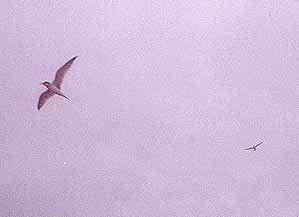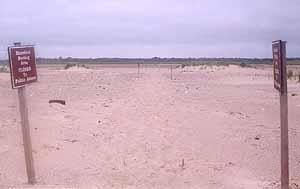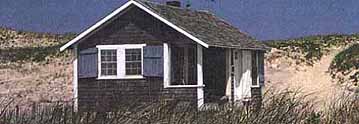Dedicated
to Henry Beston's literary classic, The Outermost House,
and the spirit of life on the Great Outer Beach of Cape
Cod

Attack
of the Piping Plovers


|
PIPING PLOVERS hover just
overhead, angry
that their area of the beach is being
disturbed -- despite the fact that the Cape
Cod National Seashore says it's OK to walk
on a designated path from the beach to
Nauset Marsh. (Photos by Don Wilding)
|
|
BY
DON WILDING
Filed June 21, 2002
For several years, the Cape Cod National Seashore has posted
signs warning beachgoers to stay off the dunes because of
the threat posed to shorebirds.
"Protecting Shorebirds" states the sign that greets
one at Coast Guard Beach in Eastham. "Beach-nesting
birds (tern and plover) must have quiet stretches of beach
for their young to hatch and grow. People and their activities
can threaten this cycle of life.
"A predator can frighten adult birds into abandoning
their nests," it continues. "A dog, even on a
leash, looks like a predator. So does a kite; shorebirds
can mistake it for a hawk."
Violations of these rules can result in fines or worse,
but after my most recent to the mile-long stretch of Nauset
Spit, the rangers or any other law enforcement folk were
the least of my concerns. No, I endured what many a beachgoer
may never experience.
It was "the Attack of the Piping Plovers."
The piping plover, now considered a "threatened species,"
is hardly an imposing creature. Measuring a staggering seven
inches, Charadrius melodus and its many different
cousins roam the beaches of Outer Cape Cod, holding a strong
preference for barrier beaches. I've always been amused
by plovers, sandpipers and sanderlings, especially with
the way that they scoot about on the sand, resembling some
sort of wind-up toy running wild.
A large part of the spit is now roped off to accomodate
the nesting birds, but the roping allows for one small path
to cut across from the beach to Nauset Marsh. The bird protectors
have OK'd this path to be used, but apparently someone forgot
to tell the plovers. The sign says, "Access to Nauset
Marsh," but not if these guys have anything to do with
it.
After roaming down the beach, I started back toward the
Coast Guard Station and figured that I'd go have a look
at the marsh. As I started to walk down the path, two plovers
began circling around my head, stopped in mid-air and hovered
about 15 feet or so above my head, chattering madly.
These birds were NOT happy. They were telling me to "get
the (censored whistling chirp) out of here. NOW."
This continued as long as I stayed on the path. A group
of walkers came through from the marsh side, so I moved
back to the beach to get out of their way. These people
must have been shaking their heads as they left, for the
birds were pulling the same stunt with them. No doubt, there
was plenty of nesting going on, and no one -- but no one
-- was going to be welcome here.
The group moved on, and I went back on to the path. The
plovers' hovering ritual continued, then one or two would
actually begin to dive-bomb in my direction, only to suddenly
turn away at the last second. I had to wonder -- these little
critters don't sit at the windows of motel windows and catch
a few glimpses of old Alfred Hitchcock movies on cable TV,
do they?
People weren't the only ones in danger. Any gulls that chose
to pass over this area were also quickly escorted away by
a dive-bombing piping plover. This area wasn't safe for
man nor beast. Even though they're only seven inches in
size, they demand respect.
There's no question that the piping plover needs an undisturbed
area for its nesting. As humans, we hog up enough of the
earth. But how much are we REALLY being told about these
piping plovers, those dive-bombing denizens of the dunes?
Maybe there's another reason why those nesting areas are
roped off. I wonder ...



